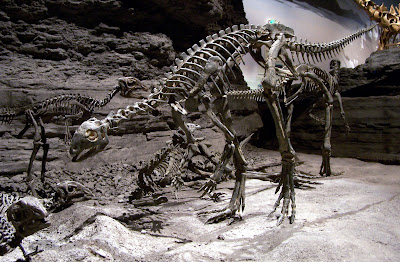
The hysilophodontidae are the most primitive members of Euornithopoda and are a sister group within this clade to Iguandontia (which encompasses all more derivied euornithopods, including the Iguanodontidae and the Hadrosauridae [duck bills]).
Facts
- The hypsilophodontidae were small (2 to 4 meters), bipedal ornithischians that are known from Middle Jurassic to Upper Jurassic rocks of North America, Europe, Asia, and Australia The best known genus is Hypsilophodon
- Bipedal runner, hind limbs much longer than forelimbs.
- Ankle elongate.
- Long tail - stiffened by ossified tendons.
- Skull resembles that of Heterodontasaurus, but does not have the large canine teeth.
- Large eyes.
- Massive jaws, dental battery of interlocking cheek teeth that wore-down to produce a continuous, inclined cutting edge.
- A joint in the skull allowed the upper jaw to move outward over the lower jaw when chewing (a dynamic skull feature).
Hypsilophodonts are well known from complete skeletons and eggs. They were first known from the Middle Jurassic of China, but reached their peak diversity during Late Jurassic to Early Cretaceous. However, they did range to Late Cretaceous.
Two euornithopods that are very similar to the hypsilophodontids, and that may be very close to the evolutionary ancestral stock that links the hypsilophodontids to the iguanodontids, are Tenontosaurus (Lower Cretaceous of North America) and Dryosaurus (Upper Jurassic of North America and Africa).
Two euornithopods that are very similar to the hypsilophodontids, and that may be very close to the evolutionary ancestral stock that links the hypsilophodontids to the iguanodontids, are Tenontosaurus (Lower Cretaceous of North America) and Dryosaurus (Upper Jurassic of North America and Africa).
Both lack premaxillary teeth and had other characters midway between the two groups (Lucas, 1997). However, some prefer to place these two dinosaurs as primitive members of Iguanodontia (which includes all more derived euornithopods above the hpsilophodontidae).

No comments:
Post a Comment